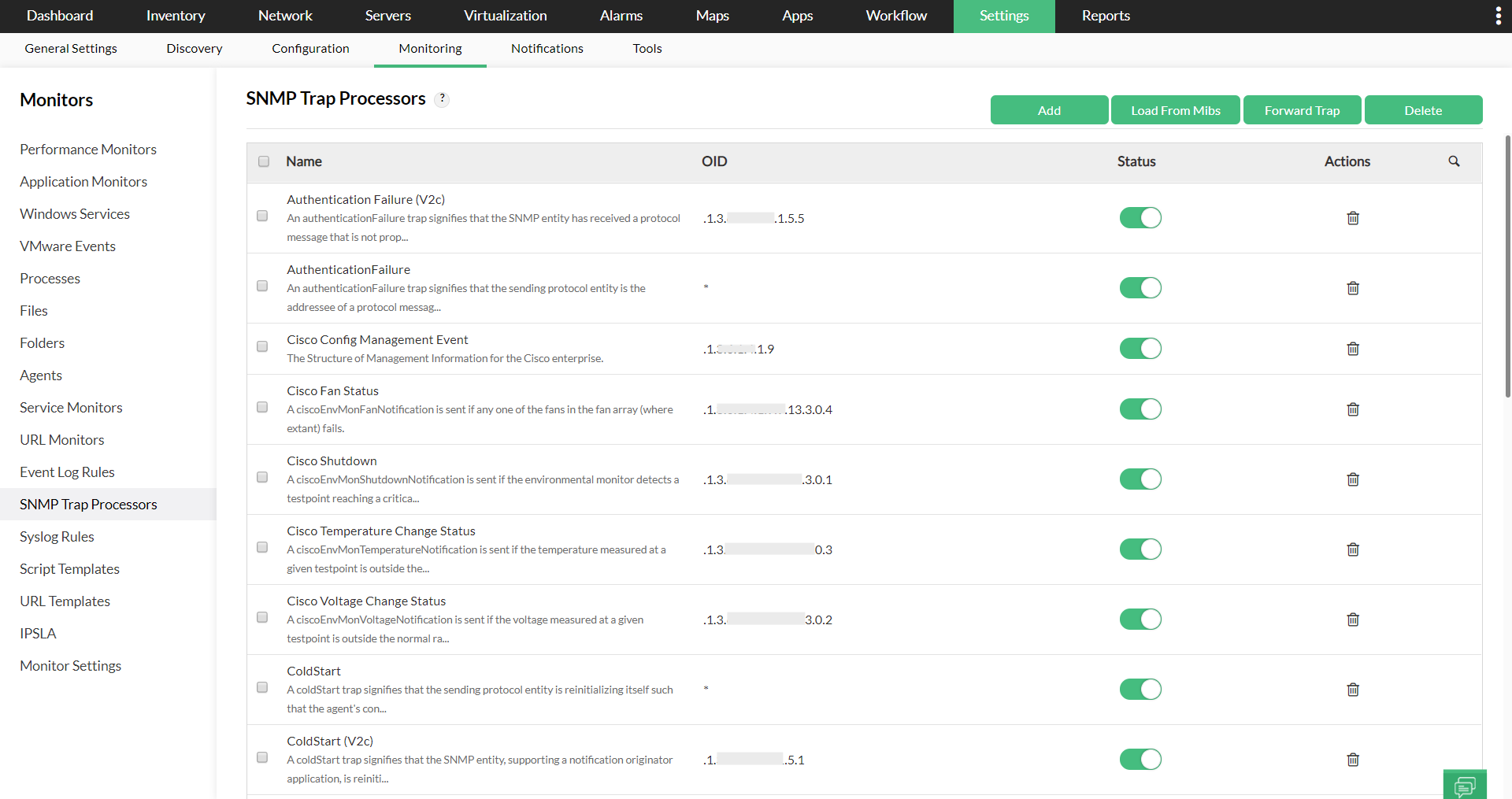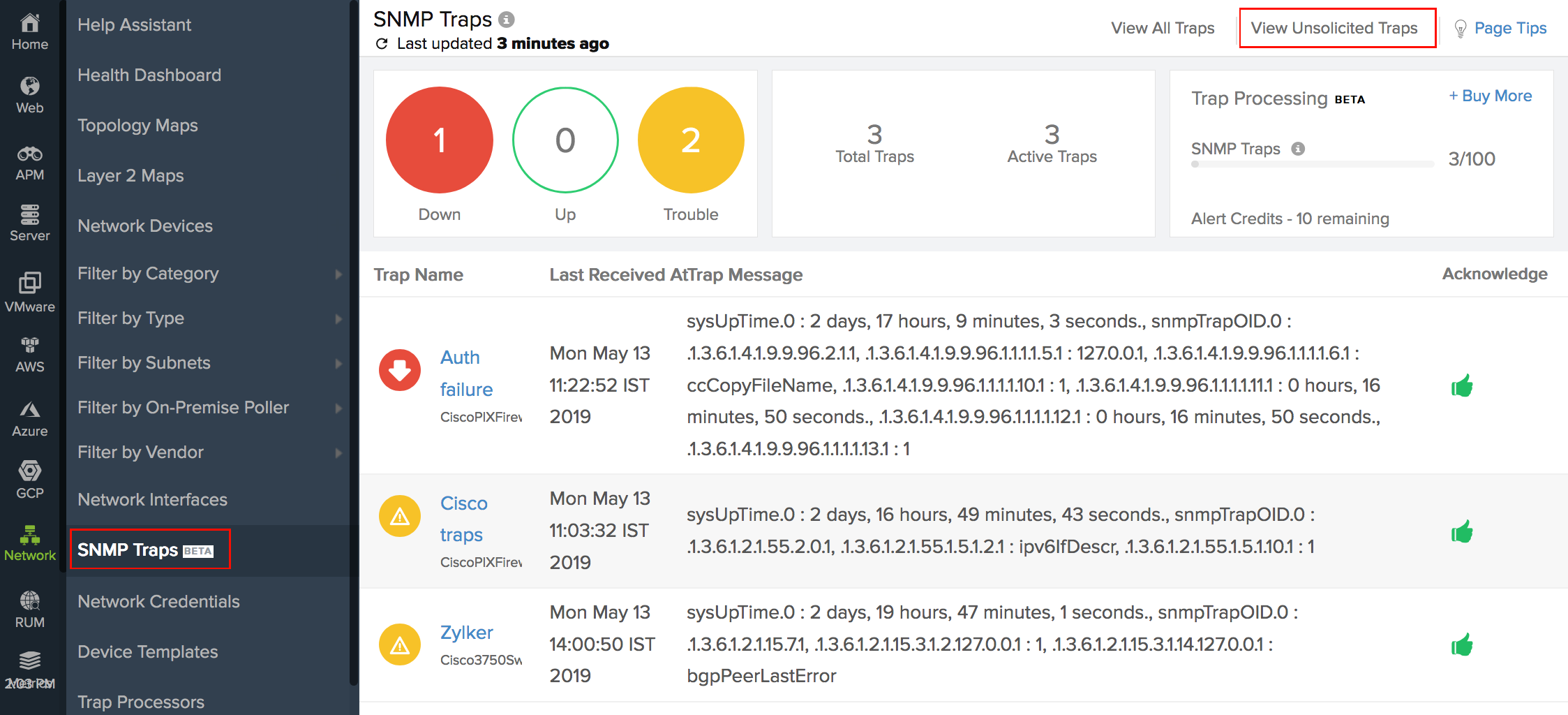
How traps are configured on each device varies between vendors and is beyond the scope of this post but it’s typically relatively easy. For instance, a router could send a trap whenever an interface goes down, a probable indication that something is wrong. Many SNMP-enabled devices can be configured so that certain events will generate traps.

In a way, SNMP traps are not unlike syslog messages.
Opmanager snmp trap receiver software#
As for the receivers, they are software tools running on a computer that receives the traps and perform various actions such as logging them, displaying on-screen alerts, sending out email or SMS alert messages, etc.

In a nutshell, SNMP traps are alert messages that are sent by SNMP-enabled devices to “trap receivers”. It is kind of a shame as it is a great feature. They once were much more commonly used but it seems that it is not so much the case anymore. SNMP traps are an often-forgotten feature of the SNMP protocol. By reading these values periodically at know intervals, the monitoring tool can compute the average number of bits per second that were transported during the polling interval. There’s a pair of them for each network interface of an SNMP-enabled device counting the bytes in and the bytes out of the interface. Of particular interest when it comes to network monitoring are a few parameters called interface counters. Let’s take a network monitoring tool as an example. In the context of network monitoring or remote configuration, an SNMP manager-which is often a monitoring tool-gets or sets a specific parameter corresponding to what it is trying to do. This is pretty much all the security there is. Whenever an SNMP manager sends a request to an enabled device, it included a community string which must match what’s configured on the equipment.

Enabled devices are configured with something called “Community Strings” which can be either read-only or read-write. There’s also not much authentication built into SNMP. SNMP requests and responses are not encrypted and can therefore easily be intercepted. Let’s first talk about the security of SNMP… or lack thereof. Our goal is not to make you an SNMP expert but rather to give you enough information so that you can understand the basics of SNMP in order to better appreciate our tool reviews. We’ll try to keep our discussion less technical. After all, they are the basic building-blocks of SNMP. Most texts about SNMP will tell you about MIBs and OIDs. SNMP is also used for remote management and configuration of SNMP-enabled devices although this use of the protocol is much less common than it once was, mainly because better technologies have been developed.Īs for SNMP Traps, they are short messages that are sent by SNMP-enabled devices to trap receiver in response to predefined events. For now, suffice to say that SNMP is mostly used by monitoring tools to read device’s operational parameters. SNMP-based management tools, no matter what type of tool they are, typically hide most of the details from you. It is also an alerting system which allows SNMP-enabled devices to send out notifications in response to certain events.įortunately, as complex as this simple technology may be, you don’t have to know everything about SNMP to use it. SNMP In A Nutshellĭespite its somewhat misleading name SNMP–which stands for Simple Network Management Protocol–is relatively complex technology that can be used to remotely monitor, configure and control many different types of networking equipment. Finally, we’ll hit the core of the matter and review some of the best SNMP trap tools we could find. We’ll tell you what they are, how they work, and what they can do for you. We’ll then specifically discuss SNMP traps. Although our goal is not to make you an SNMP expert, the different features of the available tools will be easier to understand once you know more about the protocol. We’ll start off our discussion today by having a look at SNMP. We’ve done some of the tedious work for you and we’re glad to bring this list of some of the best SNMP trap tools. There are not that many tools available and a typical search will return more SNMP monitoring tools than traps tools, no matter what search terms you use. For those who do-or for those planning to start doing it-finding tools can be a challenging endeavour. Not many people actually use the feature. In fact, although many devices have the ability to generate traps built right into their operating system or firmware.

SNMP traps, on the other hand, have not enjoyed the same relative popularity, especially in recent years. Using SNMP polling has been the primary way of monitoring network-attached equipment for as long as monitoring tools have existed. Although most network administrators are familiar with SNMP or at least have heard about it, not too many have experience with SNMP traps.


 0 kommentar(er)
0 kommentar(er)
